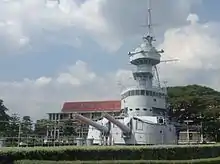Royal Thai Naval Academy
The Royal Thai Naval Academy (Thai: โรงเรียนนายเรือ) (RTNA) was established by King Chulalongkorn (Rama V) in 1898. He officially opened the academy on 20 November 1906.[1] Originally located on the royal yacht Maha Chakri and some other boats donated by the king, the academy later moved to Wang Derm Palace in Thonburi (in the compound of the present headquarters of the Royal Thai Navy), then to Sattahip, and finally to its current location in Samut Prakan in 1952. The academy is served by Royal Thai Naval Academy BTS station.[2]
โรงเรียนนายเรือ | |
 | |
| Type | Naval Academy |
|---|---|
| Established | 1898 |
| Founder | King Rama V |
| Affiliation | Thailand |
| Location | , Thailand 13.611°N 100.592°E |
| Website | Official website |

Mission
The mission of the RTNA is to train officers for the Royal Thai Navy and Royal Thai Marine Corps.
Curriculum
The RTNA provides undergraduate programs in engineering and science, combined with naval professional training. Cadets can major in electrical engineering, marine engineering, hydraulic engineering, and management science and are trained as engineers, navigators, and marines.
Graduation
Cadets graduate with a bachelor's degree in engineering or science and are commissioned in the Royal Thai Navy with the rank of ensign (sub-lieutenant). Together with graduates of the other armed forces and police academies they receive their swords from the king personally or the king's representative.
Education of Thai naval officers
.jpg.webp)
Those who want to enter the academy first have to pass the entrance exam, after which they join a two-year preparatory program at the Armed Forces Academies Preparatory School where they study together with army, air force, and police cadets.
On successful completion, they enter the Royal Thai Naval Academy. After graduation, they attend a further one-year advanced course at Sattahip that leads to a graduate diploma in naval science. On completion of this course, they are ready to work as officers in the Royal Thai Navy and Royal Thai Marine Corps.
The academy also trains police cadets destined to work at the marine police, while every year a few top graduates of the Naval Rating School for non-commissioned officers enter the academy directly after a separate entrance exam.
Selected first-year cadets of the RTNA are awarded scholarships to study at naval academies abroad. On their return to Thailand they start working as officers in the Royal Thai Navy straightaway.
Curriculum
The RTNA provides undergraduate programs in engineering and computer and materials science.
Naval Cadet Regiment, King's Guard

- 1st Cadet Battalion, Naval Cadet Regiment, King's Guard, Royal Thai Naval Academy
- 2nd Cadet Battalion, Naval Cadet Regiment, King's Guard, Royal Thai Naval Academy
- 3rd Cadet Battalion, Naval Cadet Regiment, King's Guard, Royal Thai Naval Academy
- 4th Cadet Battalion, Naval Cadet Regiment, King's Guard, Royal Thai Naval Academy
Gallery
 RTNA colours guards.
RTNA colours guards. HTMS Thonburi Memorial at the Royal Thai Naval Academy.
HTMS Thonburi Memorial at the Royal Thai Naval Academy. Inside the Royal Thai Naval Academy.
Inside the Royal Thai Naval Academy. Royal letter of King Rama V in the establishment of the Naval Academy
Royal letter of King Rama V in the establishment of the Naval Academy
See also
References
- "Royal Thai Naval Academy". RTNA. Retrieved 2008-12-01.
- "Phra Racha Wang Derm History". Wangderm Palace. Archived from the original on 2011-04-12. Retrieved 2008-12-01.
External links
- http://www.rtna.ac.th Royal Thai Naval Academy

